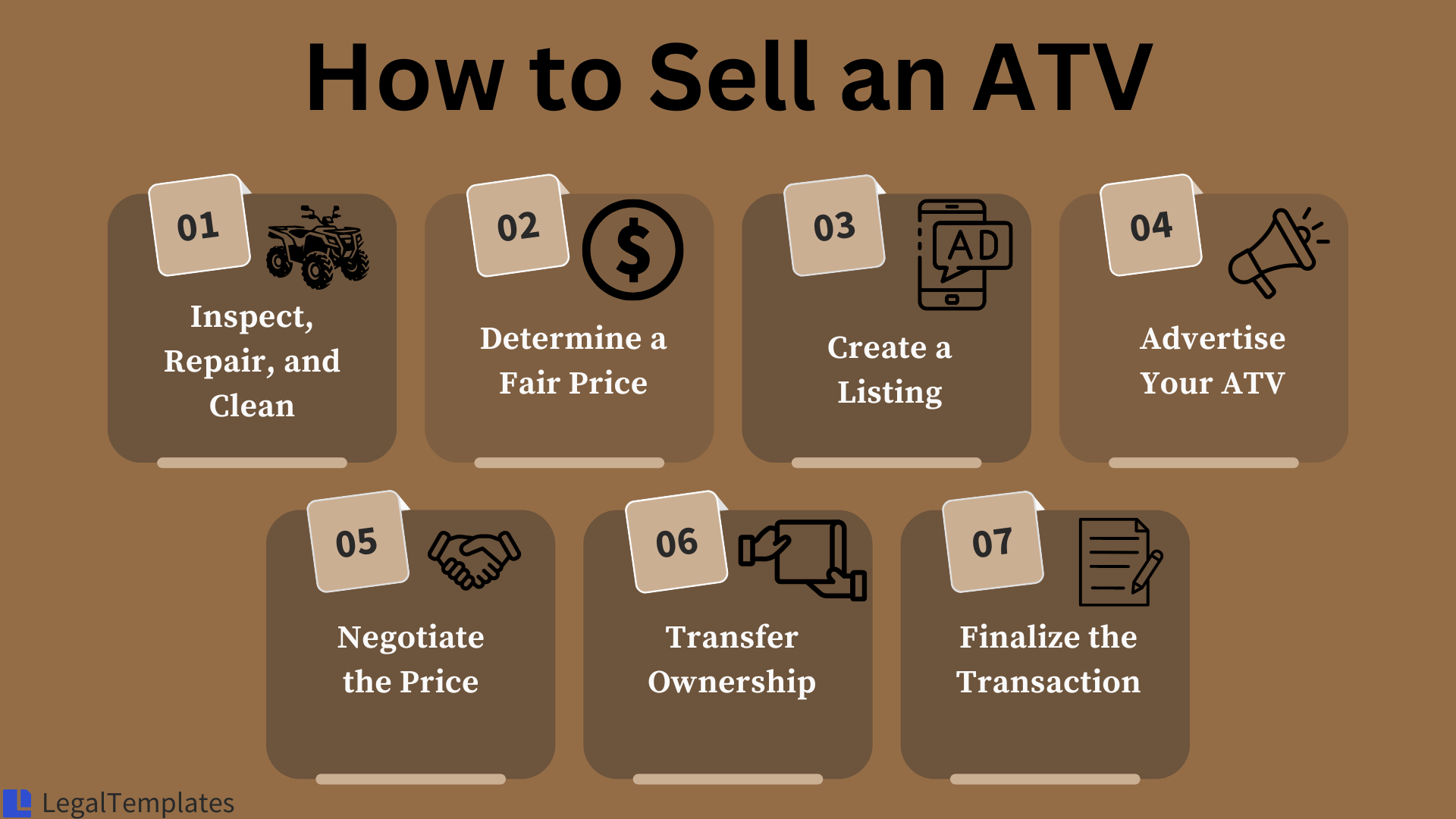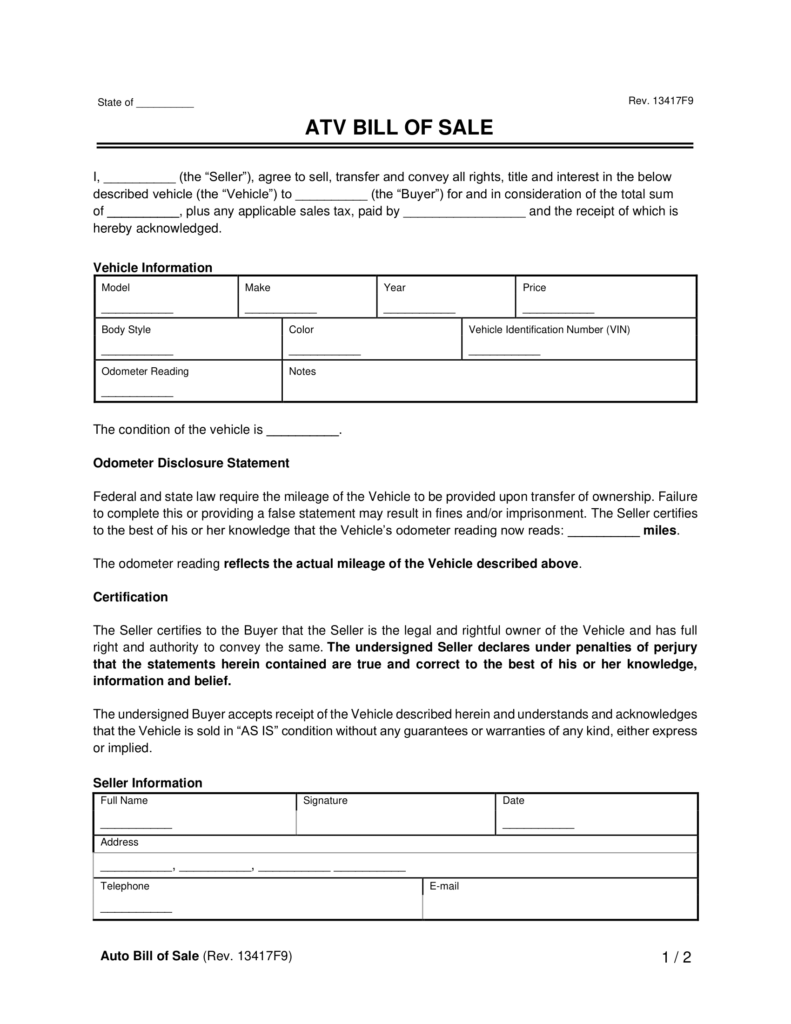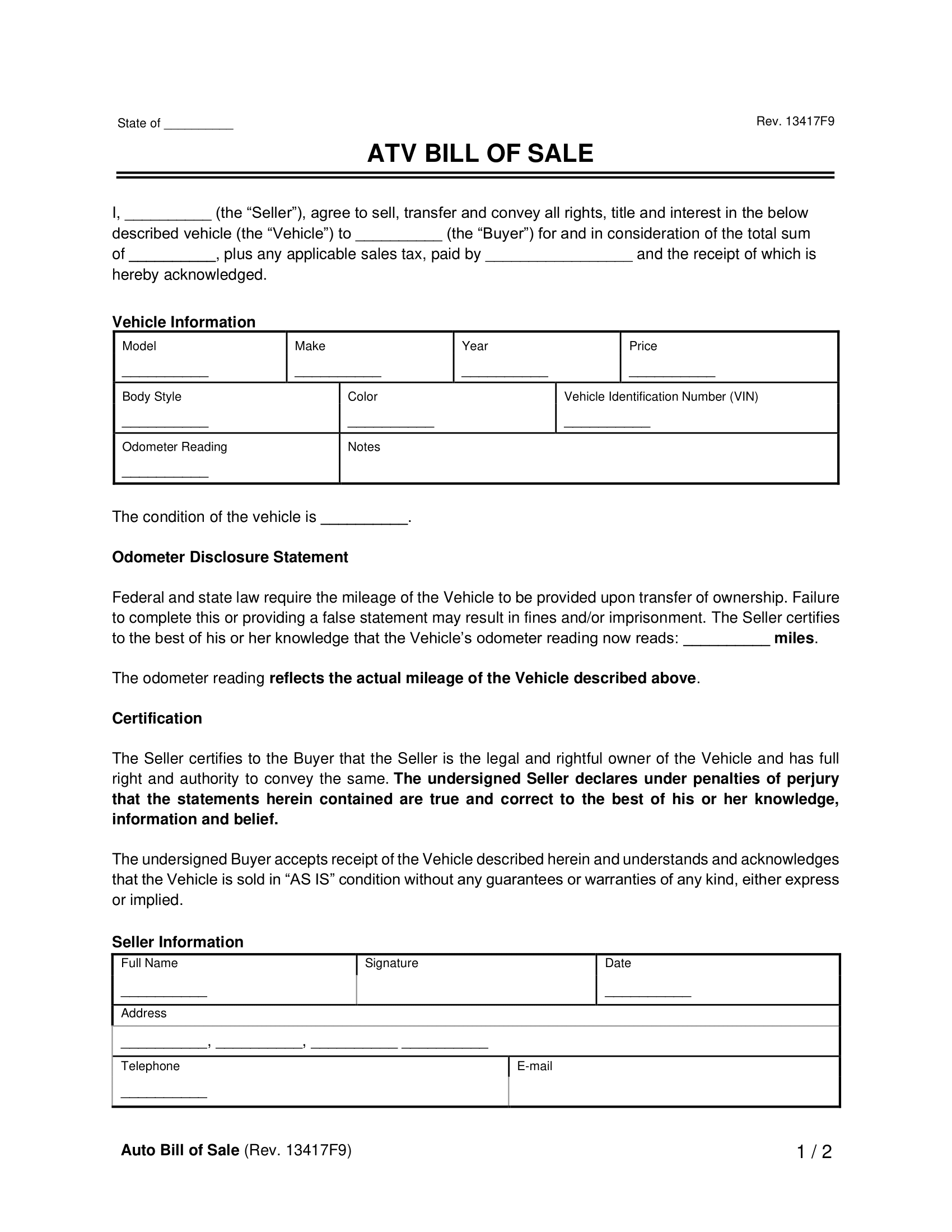An ATV bill of sale is a legal document that formalizes the details of a transaction involving the sale of an all-terrain vehicle (ATV) from one individual to another.
It serves as a crucial sale record, providing proof of the seller’s transfer of ownership to the buyer. The buyer uses this proof of ownership to register their vehicle and obtain insurance, while the seller uses it to relinquish ownership and responsibility for the ATV.
How to Sell an ATV

Step 1 – Prepare Your ATV
Prepare your ATV for sale by completing the following tasks:
- Inspect: Fully inspect to identify any problems or damage. You can remove coverings and inspect them visually, check battery terminals, look for tire damage, detect any leaks, and test the shocks. You can also perform a test drive, mainly if you haven’t used it recently, to understand its performance.
- Make repairs: Perform standard maintenance and make necessary repairs to increase your asking price. You may have to replace the spark plugs or brake pads, flush the coolant, make cable adjustments, and perform oil/oil filter changes.
- Clean: Cleaning the vehicle can help the seller make it more appealing. The cleaning process may involve washing/polishing the exterior and detailing the steering wheel, cupholders, and pedals.
Step 2 – Determine a Fair Price
Once you prepare your ATV for sale, you can determine a fair price using these tips:
- Consider the age and condition. Evaluate your ATV’s age and condition to assess its worth to a potential buyer.
- Check for comparable sales. Look up listings for vehicles of a similar make, model, age, and condition to determine what a buyer might be willing to pay.
- Get a professional inspection. Have a professional inspect your ATV to determine its value.
- Use online valuation tools. Use tools like Kelley Blue Book, J.D. Power, and Power Motorsports to estimate your vehicle’s value.
Step 3 – Create a Listing
After you settle on a fair price, create a compelling listing for your all-terrain vehicle. Include a detailed description and attach high-quality pictures so buyers know what’s available.
Step 4 – Advertise Your ATV
Advertise across various platforms to improve your chances of receiving an offer. Some common platforms include:
You can copy and paste the same listing across the different platforms. However, you may benefit from optimizing your posts for each site if you have the appropriate time and knowledge.
Step 5 – Negotiate
Negotiate with potential buyers. You may include accessories or lower the purchase price to facilitate a sale. After negotiations, you can finalize the sale of your ATV.
Step 6 – Transfer Ownership
Once the seller receives the funds, they can start the documentation of the sale and the process of transferring ownership.
Complete the bill of sale form. Sign it yourself and acquire the buyer’s signature. Have a notary present when signing the bill of sale if your state requires one.
You can also sign the ATV’s title over to the seller, as this document will further prove the new owner’s ownership. The new owner can also use it for registration and insurance purposes.
Step 7 – Finalize the Transaction
Accept payment from the buyer and issue a receipt to confirm you’ve received payment for the vehicle.
Once you’ve legally transferred ownership, physically remove your license plates to transfer the vehicle to the new owner. You can also cancel your insurance so you aren’t paying for protection you no longer need.
What to Include in an ATV Bill of Sale
Include the following essential elements in your ATV bill of sale:
- Identifying Information: Include the buyer’s and seller’s names, contact information, and addresses.
-
Vehicle Information: Be as thorough and specific as possible when providing the following vehicle information:
- Model
- Make
- Year
- Price
- Body Style
- Color
- Vehicle Identification Number (VIN)
- Condition (Excellent, Good, Fair, Poor, Salvage, etc.)
- Odometer Reading: Include the miles on the ATV or describe any circumstances affecting the listed miles.
-
Certifying Statement: The document should include the legal language necessary to transfer ownership of the vehicle to the buyer. For example, it might state, “I, [the seller], agree to sell, transfer, and convey all rights, title, and interest in the below-described vehicle to [the buyer] for the total sum of $[price], the receipt of which is at this moment acknowledged.”
- This legal language makes clear the seller intends to transfer ownership to the buyer for a specific price.
- Warranty Information: Clarify whether the sale will come with a warranty. If not, specify that the seller will receive the ATV “as-is,” meaning they accept it the way it is and will become responsible for any existing issues or defects.
- Parties’ Signatures: Acquire the buyer’s and seller’s signatures. Have them date their signatures. Failure to obtain valid signatures could result in an invalid bill of sale.
- Notary Requirements: Some states have notary requirements for this document. Check your jurisdiction’s laws to determine if you need a notary present when signing it. Even if your state doesn’t require a notary, having one present can improve the document’s validity.
What If I Need to Sell a Utility Task Vehicle (UTV)?
If you need to sell a utility task vehicle (UTV) instead of an ATV, use a UTV bill of sale to facilitate the transfer of ownership.
Sample
Download an ATV bill of sale form in PDF or Word format below:



